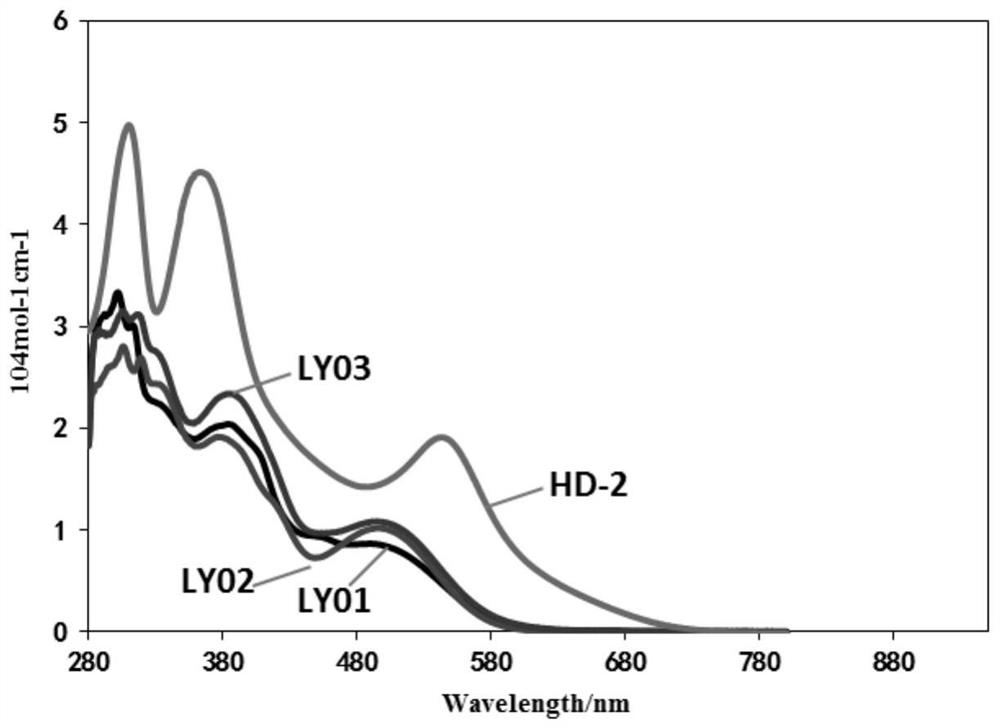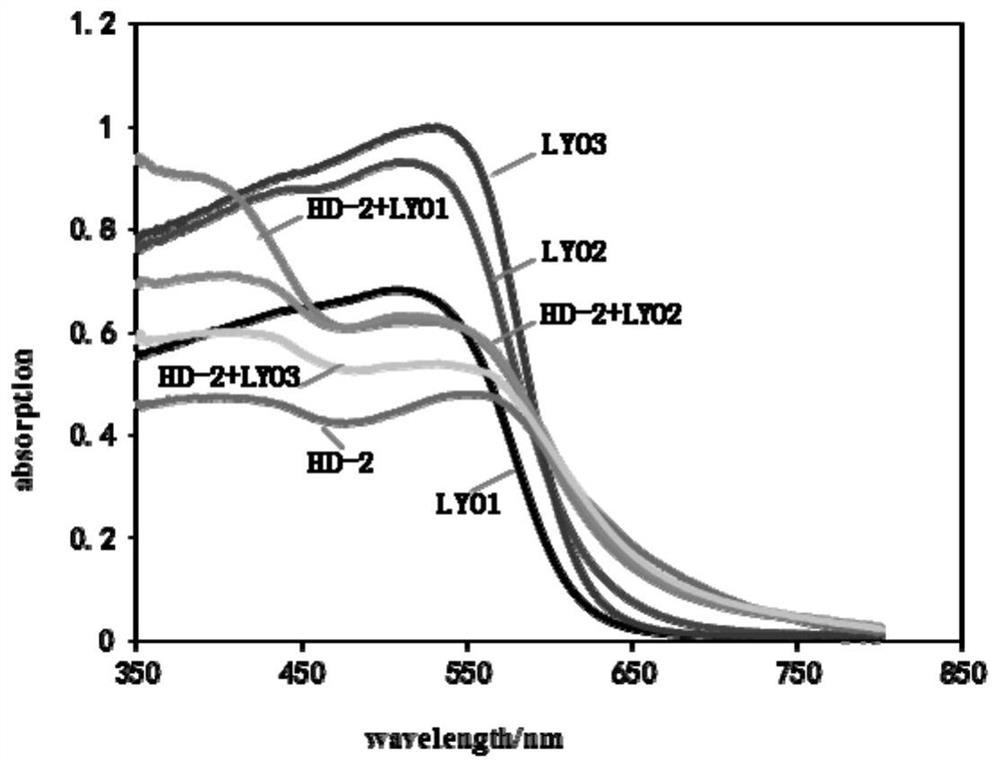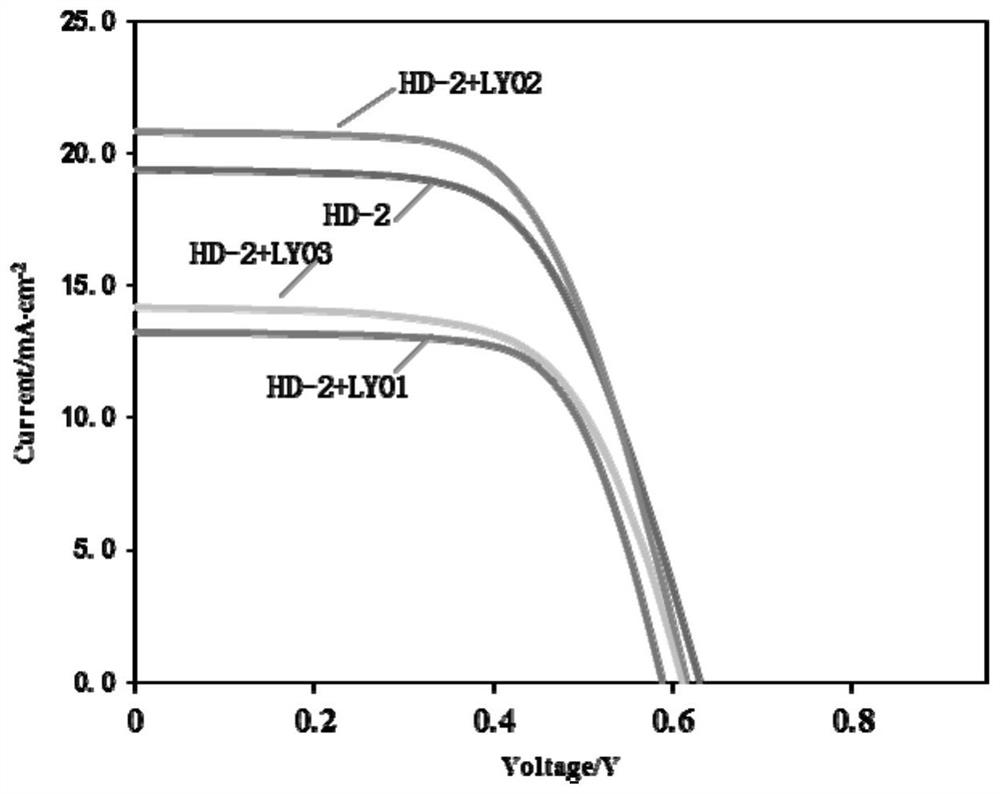High-rigidity quinoxalinyl-based co-sensitizer and co-sensitized solar cell
A quinoxaline-based, high-rigidity technology, applied in the field of dye-sensitized solar cells, can solve the problems that the efficiency of dye-sensitized solar cells needs to be improved, and achieve high efficiency, improved efficiency, and improved FF value
- Summary
- Abstract
- Description
- Claims
- Application Information
AI Technical Summary
Problems solved by technology
Method used
Image
Examples
Embodiment 1
[0028] Example 1 Test of Optical Properties
[0029] This example tested the co-sensitizers LY01-LY03 and HD-2 in DMF (2×10 -5 M) UV-Vis absorption in solution, see figure 1 . figure 1 described the co-sensitizers LY01-LY03 and HD-2 in DMF (2 × 10 -5 M) UV-Vis absorption in solution. The maximum absorption peaks (λ) of LY01, LY02 and LY03 max ) can be observed at 490 nm, 496 nm and 494 nm, respectively. like figure 2 shown, the strong absorption region around 360–400 nm of the co-sensitizers LY01-LY03 can be attributed to the π→π* electron transition of the π-conjugated structure. The absorption region (400-600 nm) corresponds to intramolecular charge transfer (ICT) between the donor and acceptor. On the other hand, the molar extinction coefficient of this region is very low (0.87 × 104 cm for LY01 -1 M -1 , LY02 is 1.02×104cm -1 M -1 , LY03 is 1.08×104cm -1 ·M -1 ). Compared with LY01-LY03, HD-2 showed a higher molar extinction coefficient in the Soret band.
...
Embodiment 2
[0031] Example 2 Test of Photovoltaic Performance
[0032] In this example, the photovoltaic performance of co-sensitized solar cells based on ruthenium-based dye HD-2 and quinoxaline-based dye LY01-LY03 was measured to evaluate the effect of co-sensitization on the photovoltaic performance of DSSCs. To improve photovoltaic performance and investigate the relationship between concentration and performance, DSSCs assembled with different concentrations of LY02 and HD-2 were investigated. The quinoxaline-based sensitizers LY01-LY03 included triphenylamine or 10-hexyl-10H-phenothiazine as a donor, a quinoxaline-based building block as a coreceptor, thiophene as a π bridge and cyanoacrylic acid as an anchor. Iodine solution (Solaronix, HI-30) was chosen as the electrolyte, and the lighting condition was set to AM 1.5. Furthermore, the co-adsorbent CDCA can effectively reduce Pt / electrolyte and FTO / TiO in DSSCs 2 Undesirable charge recombination that occurs at the / dye interface....
Embodiment 3
[0039] Figure 5 are J-V curves of devices sensitized with 0.2 mM or 0.3 mM HD-2 dye and 0.1, 0.2 or 0.3 mM sensitizer LY02, respectively. Table 2 shows the photoelectric parameters of the results. As shown in Table 2, co-sensitized DSSCs based on HD-2 and 0.2 mM LY02 exhibited better PCE (7.88%) than HD-2 alone (7.37%). Conversion efficiencies of 7.10, 7.88 and 6.34% were obtained with DSSCs co-sensitized with 0.2 mM HD-2 and 0.1, 0.2 and 0.3 mM LY02, respectively. Whereas DSSCs co-sensitized with 0.3 mM HD-2 and 0.1, 0.2 and 0.3 mM LY02 showed conversion efficiencies of 7.02, 6.56 and 6.55%, respectively. Although the devices co-sensitized with 0.2 mM LY02 and 0.2 mM HD-2 showed better results than the devices assembled with 0.2 mM HD-2 alone (19.39 mA cm -2 ) exhibited better photocurrent density (20.82 mA cm -2 ), but due to the severe competitive adsorption between LY02 and HD-2, HD-2 was adsorbed on TiO 2 The amount of adsorption on the surface was reduced, and all ...
PUM
| Property | Measurement | Unit |
|---|---|---|
| conversion efficiency | aaaaa | aaaaa |
| conversion efficiency | aaaaa | aaaaa |
Abstract
Description
Claims
Application Information
 Login to View More
Login to View More - R&D
- Intellectual Property
- Life Sciences
- Materials
- Tech Scout
- Unparalleled Data Quality
- Higher Quality Content
- 60% Fewer Hallucinations
Browse by: Latest US Patents, China's latest patents, Technical Efficacy Thesaurus, Application Domain, Technology Topic, Popular Technical Reports.
© 2025 PatSnap. All rights reserved.Legal|Privacy policy|Modern Slavery Act Transparency Statement|Sitemap|About US| Contact US: help@patsnap.com



